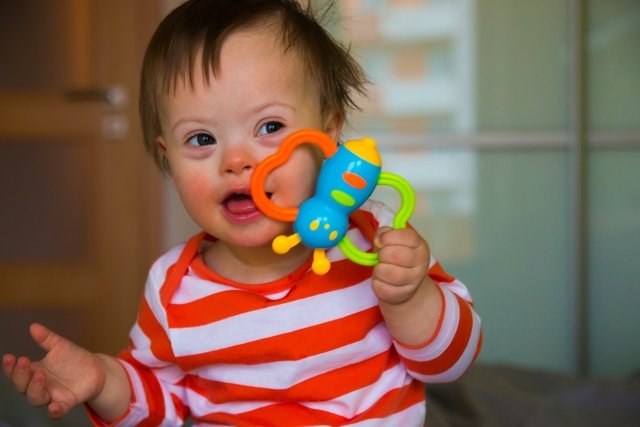Down syndrome is a genetic condition caused by a mutation in chromosome 21, causing the child to be born with specific physical characteristics such as slanted eyes, short stature or a large tongue, for example, in addition to being able to cause a series of problems with health for the child, such as heart failure or hypothyroidism.
This genetic change can also cause delays in intellectual development such as difficulty walking, speaking, learning or using your hands, for example, which can vary greatly between people with the syndrome.
However, some of these characteristics may also be present in newborns who do not have the syndrome. Therefore, the best way to confirm the diagnosis is to carry out a genetic test, with the aim of identifying the existence of changes in chromosome 21. Find out more about Down syndrome.

The characteristics of Down syndrome can be divided into three categories which include:
1. Physical characteristics
Children with Down syndrome are usually identified shortly after birth due to their physical characteristics such as:
- Rounded face;
- Almond-shaped eyes, slanted upwards;
- White spots on the colored part of the eyes;
- Small and slightly flattened nose;
- Small mouth but with a larger than normal tongue;
- Ears lower than normal;
- Short neck;
- Just a line on the palm;
- Wide hands with short fingers;
- Increased space between the big toe and the other toes;
- Muscle weakness, causing the baby to become softer.
Furthermore, children with Down syndrome are generally born with average height but grow slowly, and are therefore smaller than other children.
2. Cognitive characteristics
Children with Down syndrome may experience delays in cognitive and intellectual development, especially in skills such as:
- To walk;
- Hold objects;
- Be alert;
- Stay seated;
- Talk and learn.
The degree of these difficulties may vary from case to case, however, all children learn all these skills, although it may take longer than other children who do not have the syndrome.
To improve learning time, children with Down syndrome can participate in speech therapy sessions with a speech therapist, so that they are encouraged to express themselves earlier, facilitating the process of learning to speak, for example.
Watch the following video and find out which activities help stimulate babies with Down Syndrome:
3. Behavioral characteristics
Children with Down syndrome generally have a docile behavior, are sociable and outgoing, in addition to showing some characteristics such as:
- Impulsiveness;
- Learning difficulties;
- Difficulty paying attention;
- Obsessive behaviors.
As adults, people with Down syndrome can learn to make decisions on their own, but will likely need help with more complex issues, such as managing money or controlling pregnancy, for example. Additionally, some may go to university, while others may need more daily care.
Common health problems
In addition to common physical characteristics, people with Down syndrome are even more likely to have heart problems, such as heart failure, or thyroid diseases, such as hypothyroidism.
In almost half of cases, there are also changes in the eyes that may include strabismus, difficulty seeing far or near and, in some cases, cataracts.
As most of these problems are not easy to identify in the early days, it is common for the pediatrician to carry out several tests during childhood, such as ultrasound, echocardiogram or blood tests, to identify whether there is any associated disease. See all recommended exams for children with Down syndrome.
Bibliography
- HUIRACOCHA, L.; et al. Parenting children with Down syndrome: Societal influences. . J Child Health Care. 21. 4; 488-497, 2017
- WINDERS, Winders P.; et al. A schedule of gross motor development for children with Down syndrome. J Intellect Disabil Res. 63. 4; 346-356, 2019
- BONT, CW; BUNT, SK Role of the family physician in the care of children with Down syndrome. Am Fam Physician. 90. 12; 851-8, 2014
- AGARWAL, Gupta N.; GOAT, Goat. Diagnosis and management of Down syndrome. Indian J Pediatr. 2014 Jun;81(6):. 81. 6; 560-7, 2014
- GRIECO, J.; et al. Down syndrome: Cognitive and behavioral functioning across the lifespan. . . . Am J Med Genet C Semin Med Genet. 169. 2; 135–49,
- ROIZEN, N. J.; PATTERSON, D. Down’s syndrome. Lancet. 361. 9365; 1281-9, 2003
- BULL, M. J. Down Syndrome. N Engl J Med. 382. 24; 2344-2352, 2020
- ARUMUGAM, A.; et al. Down syndrome-A narrative review with a focus on anatomical features. Clin Anat. 29. 5; 568-77, 2016





